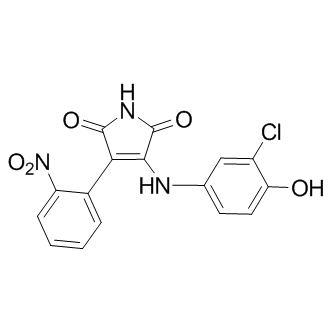| Cas No.: | 264218-23-7 |
| Chemical Name: | SB-415286; SB415286 |
| Synonyms: | SB-415286; SB415286 |
| SMILES: | O=C(C(NC1=CC=C(O)C(Cl)=C1)=C2C3=CC=CC=C3[N+]([O-])=O)NC2=O |
| Formula: | C16H10ClN3O5 |
| M.Wt: | 359.7207 |
| Sotrage: | 2 years -20°C Powder, 2 weeks 4°C in DMSO, 6 months -80°C in DMSO |
| Description: | SB 415286 is a potent and selective cell permeable inhibitor of GSK-3α, with an IC50 of 77.5 nM, and a Ki of 30.75 nM; SB 415286 is equally effective at inhibiting human GSK-3α and GSK-3β. |
| In Vitro: | SB 415286 (SB-415286) inhibits human GSK-3α with an IC50 of 77.5 nM, and a Ki of 30.75 nM. SB-415286 stimulates glycogen synthesis in the Chang human liver cell line with EC50 of 2.9 μM. SB-415286 stimulates glycogen synthase activity in Chang human liver cells. SB-415286 induces transcription of a β-catenin-LEF/TCF regulated reporter gene in HEK293 cells[1]. SB 415286 (SB-415286, 5-44 μM) attenuates B65 cell loss mediated by 1 mM H2O2. SB-415286 (5-44 μM) causes a significant dose-dependent decrease in the fluorescence intensity of DCF, and attenuates B65 ROS production as mediated by 1 mM H2O2. SB-415286 (5-44 μM) also attenuates ROS production in CGN mediated by 1 mM H2O2[2]. SB-415286 (50 µM) induces a substantial suppression of immunoprecipitated GSK3 activity by 97%[3]. |

 DC Chemicals' products qualify for U.S. tariff exemptions. We guarantee no price increases due to customs duties and maintain stable supply, continuing to deliver reliable research solutions to our American clients.
DC Chemicals' products qualify for U.S. tariff exemptions. We guarantee no price increases due to customs duties and maintain stable supply, continuing to deliver reliable research solutions to our American clients.





















